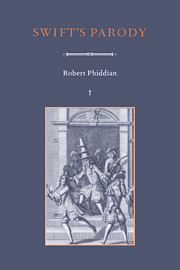Book contents
- Frontmatter
- Contents
- Acknowledgments
- List of abbreviations
- Introduction
- 1 Theoretical orientations
- 2 Restoration enterprises and their rhetorics
- 3 Parody and the play of stigma in pamphlet warfare
- 4 The problem of anarchic parody: An Argument against Abolishing Christianity
- 5 Authority and the author: the disappearing centre in Swiftian parody
- 6 Entrance to A Tale of A Tub
- 7 A Tale of A Tub as an orphaned text
- 8 A Tale of A Tub as Swift's own illegitimate issue
- Conclusion: parodic disguise and the negotiability of A Tale of A Tub
- Select bibliography
- Index
1 - Theoretical orientations
Published online by Cambridge University Press: 29 September 2009
- Frontmatter
- Contents
- Acknowledgments
- List of abbreviations
- Introduction
- 1 Theoretical orientations
- 2 Restoration enterprises and their rhetorics
- 3 Parody and the play of stigma in pamphlet warfare
- 4 The problem of anarchic parody: An Argument against Abolishing Christianity
- 5 Authority and the author: the disappearing centre in Swiftian parody
- 6 Entrance to A Tale of A Tub
- 7 A Tale of A Tub as an orphaned text
- 8 A Tale of A Tub as Swift's own illegitimate issue
- Conclusion: parodic disguise and the negotiability of A Tale of A Tub
- Select bibliography
- Index
Summary
Three theories of quotation
If one were looking for a theory of quotation to describe the practice of Swiftian parody, it would be difficult to better this:
We now know that a text is not a line of words releasing a single ‘theological’ meaning (the ‘message’ of the Author-God) but a multi-dimensional space in which a variety of writings, none of them original, blend and clash. The text is a tissue of quotations drawn from innumerable centres of culture. Similar to Bouvard and Pécuchet, those eternal copyists, at once sublime and comic and whose profound ridiculousness indicates precisely the truth of writing, the writer can only imitate a gesture that is always anterior, never original. His only power is to mix writings, to counter the ones with the others, in such a way as never to rest on any one of them.
Swift's parodic writing is restless, allusive, and eccentric, its status easily imagined as ‘a multi-dimensional space in which a variety of writings, none of them original, blend and clash’, and as ‘a tissue of quotations drawn from innumerable centres of culture’. Swiftian narrators, ‘those eternal copyists’, are displaced from the authoritative centres of their texts, leaving a space that Swift fills only fugitively and problematically with his presence.
- Type
- Chapter
- Information
- Swift's Parody , pp. 6 - 23Publisher: Cambridge University PressPrint publication year: 1995

